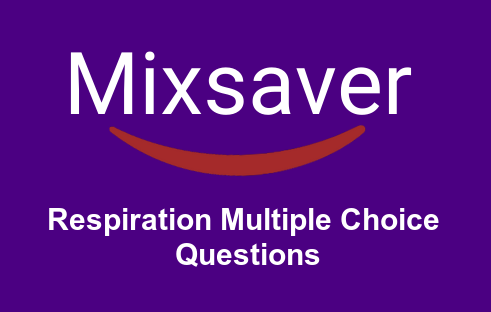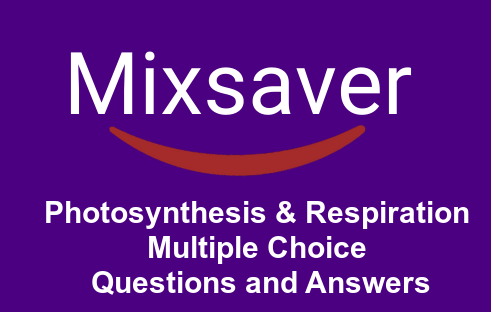Respiration MCQs with Answers
1. For each glucose molecule that is broken down in glycolysis there is a net gain of
(a) 1 ATP molecule
(b) 8 ATP molecules
(c) 3 ATP molecules
(d) 4 ATP molecules
Ans. b
2. Which of the following enzymes catalyses non-reversible reaction in glycolysis?
(a) Phosphofructokinase
(b) Enolase
(c)Triose phosphate isomerase
(d) Phosphohexose isomerase
Ans. a
3. Glucose 6 phosphate inhibits which of the following enzymes?
(a) Hexokinase
(b) Glucokinase
(c) Phosphorylase kinase
(d) Fructose-1, 6-bisphosphatase
Ans. a
4. Glucokinase is characterised by
(a) it has a much higher Michaelis constant for glucose than hexokinase
(b) it is an allosteric enzyme
(c) it is found in most cells
(d) it phosphoryiates most hexoses
Ans. a
5. The oxidation of 1 mole of glucose by anaerobic glycolysis yields a net of
(a) 2 moles of acetyl Co-A and 2 moles of ATp
(b) 2 moles of lactate and 2 moles of ATP
(c) 2 moles of lactate, 2 moles of NAD and 6 moles of ATP
(d) 2 moles of lactate, 2 moles of NADH and 2 moles of ATP
Ans. b
6. The end product of fermentation of molasses by yeast is
(a) pyruvate
(b) ethyl alcohol
(c) lactate
(d) methyl alcohol
Ans. b
7. Flouride inhibits which glycolytic enzyme
(a) enolase
(b) glucokinase
(c) phosphofructokinase
(d) lactate dehydrogenase
Ans. a
8. Iodoacetate inhibits which glycolytic enzyme
(a) hexokinase
(b) enolase
(c) glyceraldehyde 3 phosphate dehydrogenase
(d) phosphoglycerate kinase
Ans. c
9. Glycolysis occurs in
(a) mitochondria
(b) cytosol
(c) Both (a) and (b)
(d) nucleus
Ans. b
10. Which enzyme is not present in muscle?
(a) Hexokinase
(b) Glucose 6 phosphatase
(c) Glycogen synthase
(d) Phosphorylase
Ans. b
Cellular Respiration mcq pdf | Breathing and Exchange of Gases NEET MCQ pdf
11. Which glycolytic enzyme ia used in luconeogenesiat
(a) Pyruvale kinase le
(b) Guccirase
(c) Aldolase
(d) Phosphogyoerate kinase
Ans. d
12. Which enzyme cleaves C-Cbond in glycolysist
(a) Aldolase tid
(b) Enolase
(c) Phosphogycerate kinase
(d) Phosproglycerate mutase
Ans. a
13. Which enzyme is inhibited by arsenate?
(a) Glyceraldehyde 3 phosprate dehydrogenase
(b) Lactate dehydrogenase
(c) Hexckinase
(d) Phosphofructokinase
Ans. a
14. In embryo with complete deficiency of pyruvate kinase, how many net moles of ATP would be generated in conversion of one mole of glucose to one mole of pyruvate?
(a) 0
(b) 1
(c) 2
(d) 3
Ans. a
15. Malonate is an Inhibitor of
(a) citrate synthase
(b) aconitase
(c) succinate dehydrogenase
(d) malate dehydrogenase
Ans. c
16. Which enzyme in TCA cycle is involved in formation of GTP from GDP?
(a) Succinate dehydrogenase
(b) Malate dehydrogenase
(c) Citrate synthase
(d) Succinyt Co-A synthetase
Ans. d
17. Which vitamin is required for the synthesis of cofactor needed for in conversion of succinate to fumarate
(a) Ribofiavin
(b) Thiamine
(c) Lipoic acid
(d) Niacin
Ans. a
18. Which of the following is utilised as precursor for choiesterol biosynthesis?
(a) Succinyl Co-A
(b) Acetyl Co-A
(c) Succinate
(d) Malate
Ans. b
19. How many molecules of CO, are produced per mole of acetyl Co-A in TCA cycle?
(a) 2
(b) 1
(c) 3
(d) 4
Ans. a
20. Which of the following is a component of succinate dehydrogenase in electron transport chain?
(a) Niacin
(b) FMN
(c) FAD
(d) Coenzyme-Q
Ans. c
MCQ on Aerobic and Anaerobic Respiration | MCQ on Respiration in Animals
21. Which of the following ETC components accepts only one electron?
(a) Cytochrome-b
(b) Oxygen esk
(c) FAD
(d) FMN
Ans. a
22. Which of the following enzymes catalyses the conversion of hydrogen peroxide to water?
(a) Hydratase
(b) Catalase
(c) Dioxygenase
(d) Dismutase
Ans. b
23. Choose a site along ETC that is ot coupled to ATF synthesis.
(a) Succinate Co Q reductase
(b) Cytochrome axidase
(c) NADH Co Q reductase
(d) None of the above
Ans. a
24. ADP transport into mitochondrial matrix is
(a) directly inhibited by valinomycin
(b) accompanied by ATP export from mitochondrial matrix
(c) inhibited by rotenone
(d) an active transport process
Ans. b
25. Which process does not involve cytochrome-c?
(a) Apoptosis
(b) TCA cycle
(c) Electron transport
(d) Oxidative phosphorylation
Ans. b
26. How many ATPS are formed per glucose molecule in Krebs’ cycle?
(a) 2
(b) 24
(c) 6
(d) 28
Ans. b
27. Number of oxygen molecules required during glycolysis of one glucose molecule is
(a) 38
(b) 36
(c) 2
(d) zero
Ans. d
28. Which is rich in energy?
(a) NAD
(b) Mitochondria
(c) FAD
(d) ATP
Ans. d
29. What occurs in glycolysis?
(a) Fixation
(b) Reduction
(c) Dehydrogenation
(d) Oxidation
Ans. c
30. Cytochrome possess
(a) Mg
(b) Fe
(c) Mn
(d) Na
Ans. b
Respiration in plants mcq for neet pdf | Respiration neet mcq pdf
31. Krebs’ cycle is considered to be important because of
(a) production of pyruvic acid
(b) production of oxalo acetic acid
(c) production of ATP through oxidative phosphorylation
(d) production of H2O
Ans. c
32. ATP is a
(a) protein
(b) enzyme which bring oxidase
(c) a molecule with high energy phosphate bonds
(d) hormone
Ans. c
33. Mitochondria as an organellele is concerned with
(a) cellular respiration
(b) protein synthesis
(c) DNA synthesis
(d) cellular digestion
Ans. a
34. For glycolysis to occur, enzymes are found inside the
(a) cytoplasm
(b) mitochondrial matrix
(c) oxosomes
(d) ribosome
Ans. a
35. The number of ATP molecules produced by one molecule of glucose is
(a) 30
(b) 24
(c) 38
(d) 48
Ans. c
36. Identify the number of ATP molecules produced outside mitochondria during glucose oxidation.
(a) 20
(b) 4
(c) 2
(d) 14
Ans. c
37. Glycolysis takes place mostly in
(a) white muscle fibres
(b) red muscle fibres
(c) liver cells
(d) All living cells
Ans. d
38. Which out of these links EMP with TCA cycle?
(a) Acetyl Co-A
(b) Pyruvic acid
(c) Oxaloacetic acid
(d) NADH2
Ans. a
39. In Krebs’ cycle the 6C compound is formed by the combination of acetyl Co-A with
(a) oxalosuccinate
(b) maleic acid
(c) isocitric acid
(d) oxaloacetic acid
Ans. d
40. Identify the common element to be found between NA and ATP is
(a) Ca+2
(b) Mg+2
(c) PO4-
(d) Mn+2
Ans. c
41. Which cytochrome has both Cu and Fe elements?
(a) Cytochrome-b
(b) Cytochrome-c
(c) Cytochrome-a
(d) Cytochrome-a3
Ans. d
42. Which is the rate limiting enzyme in glycolysis?
(a) Hexokinase
(b) Isomerase
(c) Enolase
(d) Phosphofructose kinase
Ans. d
43. Which is not a prosthetic group or coenzyme used during oxidation of pyruvate?
(a) TPP
(b) Co-A
(c) Lipoic acid
(d) Mn2+
Ans. d
44. The end products produced in ETC is
(a) NADH,
(b) ATP
(c) ATP + H2O
(d) O2
Ans. c
45. ETC in eukaryotes involves
(a) oxidation reaction
(b) reduction reaction
(c) redox reaction
(d) None of these
Ans. c





